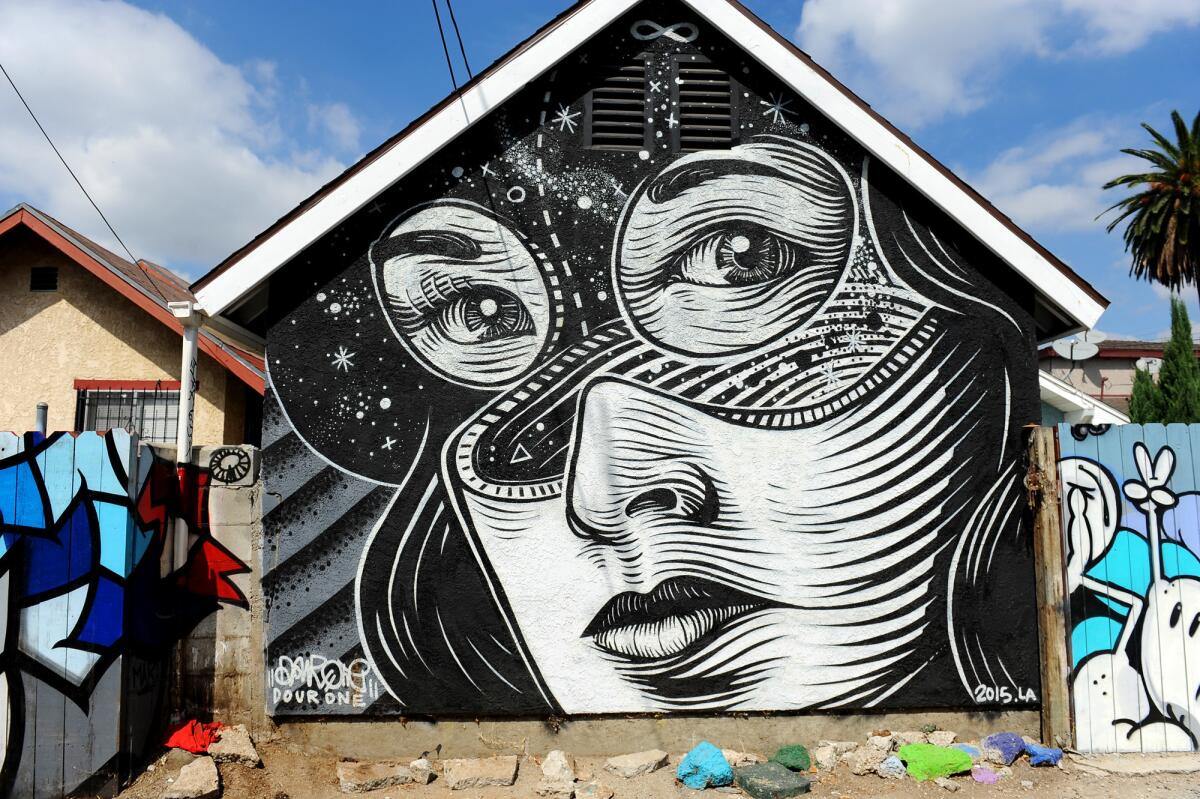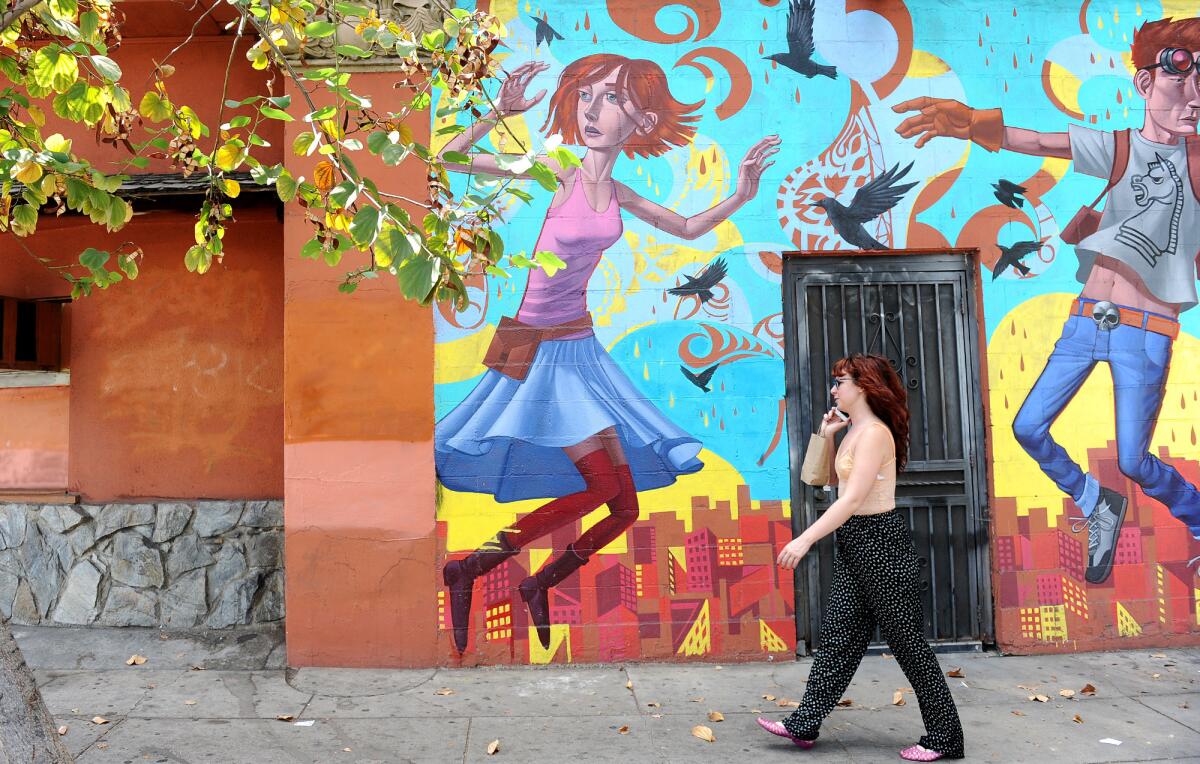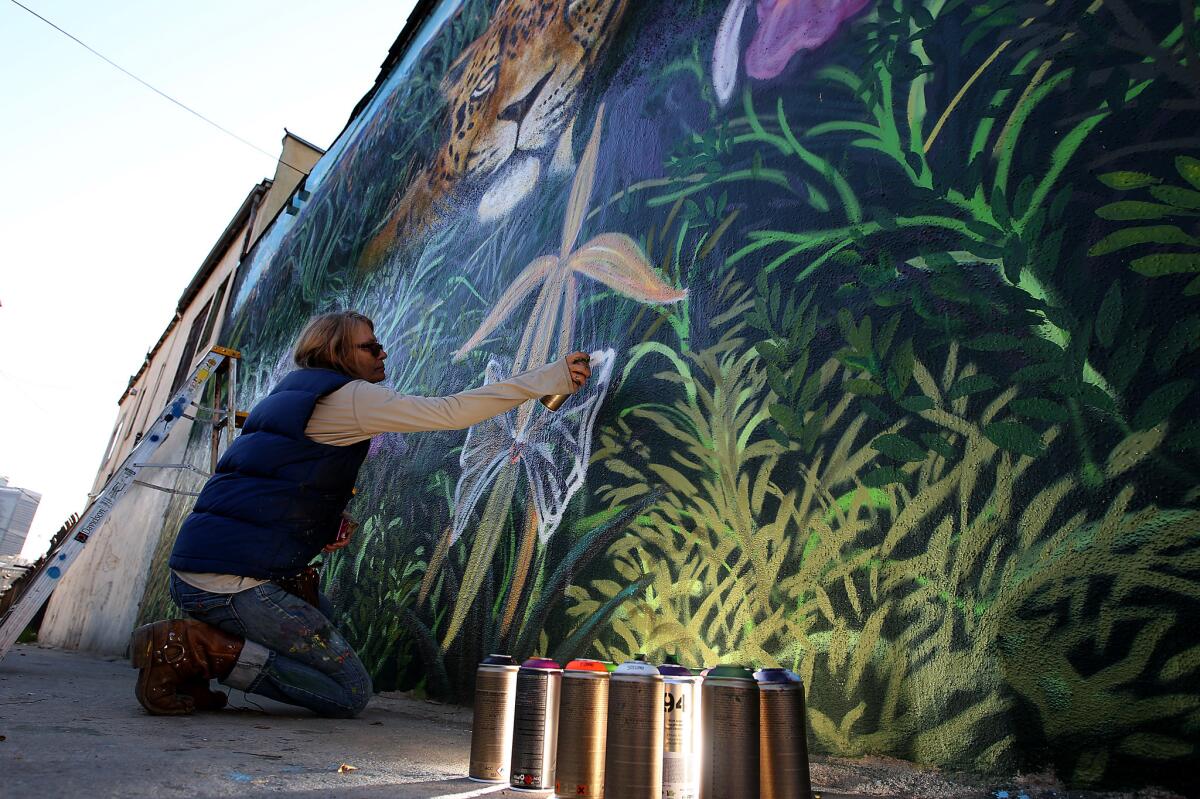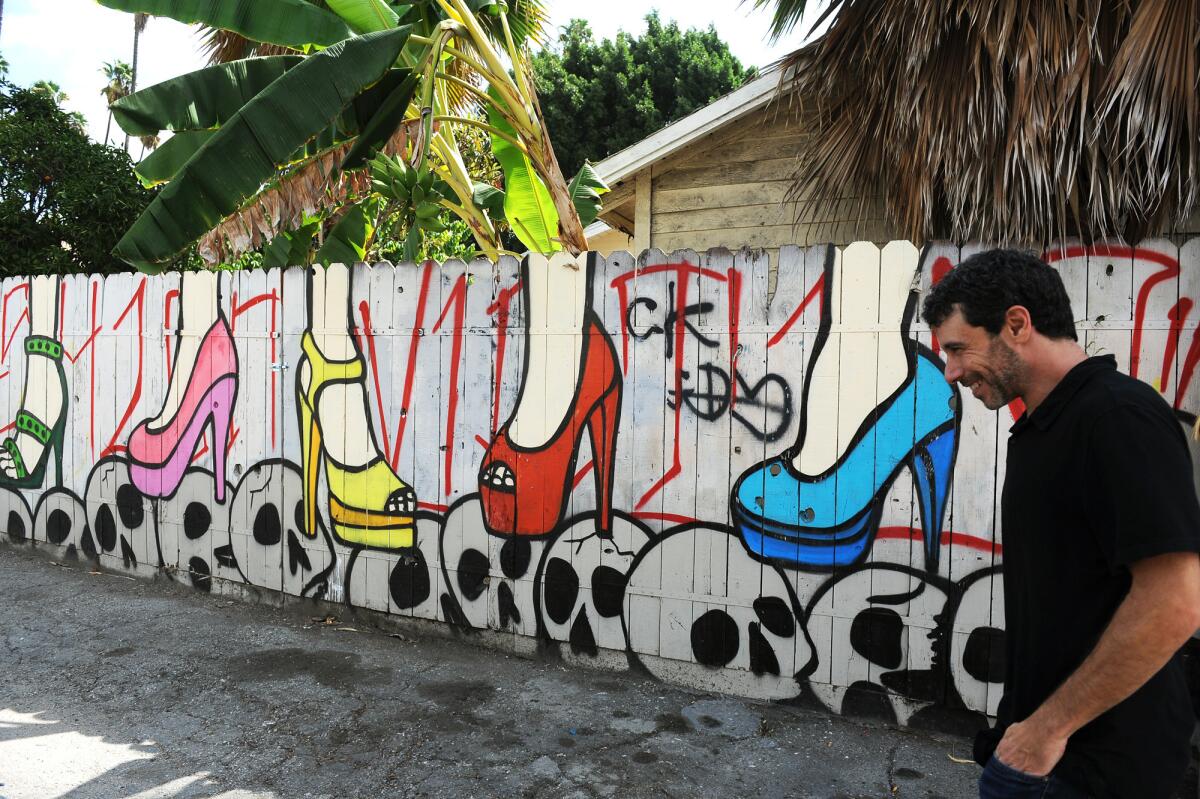Murals turn blighted L.A. alleys into an outdoor art gallery

The Spanish-French duo known as Dourone created a black-and-white portrait of a face staring from infinity as part of L.A. artist Jason Ostro’s Alley Project.
- Share via
Jason Ostro walks the narrow alleyways off Beverly Boulevard near downtown L.A. and beams at the explosion of color around him. Until recently, these passages were strewn with litter, discarded mattresses and rusty bikes.
“When we moved into the neighborhood three years ago, there was so much garbage and graffiti around here,” says Ostro, owner of the nearby Gabba Gallery.
Not satisfied with cleaning up his patch of the neighborhood, the gallerist launched a public art initiative, the Alley Project, which has produced more than 90 murals by about 80 local and international artists.
“The whole idea,” he says, “was turn blight into bright.”
The side-by-side murals, a mishmash of colors and styles, cover nearly every vertical surface, including garage doors, window bars, even trash bins. Three alleys have been completed since work began in April; production on a fourth is expected to start in late January.

Bright colors and whimsy predominate in a piece completed by artist John Park for the Alley Project, taking place in locations off Beverly Boulevard.
See more of Entertainment’s top stories on Facebook >>
At the moment, though, Ostro is mired in monkey business. He broke ground on a separate mural project this month, “Animal Alley L.A.,” in Echo Park. The mostly residential backstreet off Glendale Boulevard, behind the Bob Baker Marionette Theater, is not officially part of the Alley Project; “it’s a satellite mural project,” Ostro says. Nonetheless, the alleyway is now filled with fierce animal-themed works by 15 artists, some of whom have flown in from as far as South America to participate in the project.
Midway through production on Animal Alley, the otherwise quiet street is filled with scissor lifts, dumpsters and buckets filled with spray-paint cans. A dozen artists toil side by side as Mexican pop music blasts from a nearby satellite radio. Blake Shane is creating a sculptural installation — the face of a bird made from strips of coffee-can metal — as his blue-and-gold macaw, Laszlo, sits on his shoulder.
“Love it, lookin’ good,” Ostro says.
“Excellent,” coos Shane’s macaw, flapping its wings. “Wassup? Hola. Hi, Hi, Hi!” the bird chatters as Ostro wanders off to peruse the other works-in-progress.
Ostro’s enthusiasm for public art is hardly an anomaly in L.A., which has seen a resurgence of mural production since the city in 2013 lifted a nearly 10-year ban on new works. In September, the Los Angeles Department of Cultural Affairs announced the new Citywide Mural Program, for which $750,000 will be spent on the restoration and preservation of historic fine art murals plus the development of new ones. The downtown arts district, loaded with kaleidoscopic color, has become a veritable outdoor museum for murals by artists from around the globe.

Andrea LaHue, also known as Random Act, works on a piece inspired by the South American jaguar because of its spiritual quality.
The Gabba Gallery paid to put up many of the Beverly and Echo Park works. Ostro also secured sponsors, among them art supply store Blick and real estate developer Light Space & Shadow, which is renovating a building in the Beverly area and, Ostro says, made a five-figure donation to the project. He’s also gone door to door, knocking on mostly homes to gain permission to use building exteriors as canvases.
The first Alley Project mural was Swiss-born German artist Raphael Grischa’s multicolored eagle, wings spread, on the side of a Beverly Boulevard building across the street from Ostro’s gallery.
“I think it shows that street art is a viable art form,” Ostro says. “I love how it’s broken apart, and the detail of it, and the color combination — it gives the project freedom and this sense of wonderment and interest.”
Week after week, mural by mural, the Alley Project has inched forward, generating curiosity as more people stop to ask questions and check out the art in a neighborhood the city calls Historic Filipinotown.

Jason Ostro walks past work by artist Jules Muck.
“Alley Project #3” — bordered by Beverly, Vendome, Reno and Council streets — has more than 22 works. Australian artist Stormie Mills’ mural depicts two childlike skeletons playing a dice game. L.A.-based Peter Greco’s signature florid “caligraffiti” run up and down a garage door. A bold, clownlike face by Aussie Anthony Lister fronts another garage door.
Grischa and L.A.-based New Zealander Clinton Bopp collaborated on a jewel-toned sideways giraffe beside a cigar-smoking monkey. A black-and-white portrait of a face with infinity markings is by Spanish-French duo Dourone.
In the tradition of murals bearing messages, a work by local artist Wrdsmth faces an elementary school and reads, “You are amazing. And you deserve amazing,” over the image of an old-fashioned typewriter. A spray can-wielding robot, by local artist Skid Robot, is meant to bring awareness about skid row and homelessness.
“I wanted positive messages,” Ostro says.
Toward that end, Ostro has branched out with the new Animal Alley L.A. “I thought that would bring a lot of happiness and joy,” he says. Production on the project started Dec. 14 and Ostro aims to have 25 to 30 artists in all add works to the alleyway throughout the month.

Jules Muck paints a tabby cat with angel’s wings.
About half a dozen muralists or art duos were on board at the start: Dourone painted an ode to endangered animals featuring two Tibetan macaques. Bopp teamed with a local artist who goes by the name Random Act for a jungle-themed work featuring the former’s bees and hummingbirds and the latter’s orchids.
“The piece is inspired by the South American jaguar because of its spiritual quality,” Random Act says. “It’s uniting the mind, body and spirit.” The mural also features graffiti elements growing out of jungle weeds. “That’s our way of tipping our hat to contemporary life today,” she says.
The Chilean German artist Otto Schade created a 75-foot-wide piece depicting marching elephants against a night sky; Venice-based Jules Muck painted a tabby cat with angel’s wings; the artist known as Phobik painted a towering cheetah. Ostro wants other artists to add aerosol paintings, yarn-bombing works or small sculptural installations in the ensuing weeks.
The Filipinotown and Echo Park projects follow a deep tradition of communities and individuals expressing themselves through public art in L.A., considered a mural capital. As part of the city’s initiative, the Social and Public Art Resource Center (better known as SPARC) is restoring nine historic murals, including Roderick Sykes’ 1989 “Literacy,” now underway, as well as Yreina Cervantez’s 1988-89 “La Ofrenda” and George Yepes’ 1989 “Mujer del Este de Los Angeles.” The Mural Conservancy of Los Angeles will restore the 1973 Boyle Heights collaboration between artists Willie Herrón III and Gronk titled “Moratorium: The Black and White Mural” as well as Judithe Hernández’s 1977 “Homenaje a Las Mujeres de Aztlan,” a collaboration with Carlos Almaraz of the Ramona Gardens housing project.

Artist Andrea LaHue, also known as Random Act, talks about her mural for “Animal Alley L.A.” in Echo Park.
The arts organization Branded Arts this month completed a six-story acrylic mural, hand-painted with brushes and rollers, by the Polish art duo Etam Cru. The downtown L.A. fashion district work depicts the profile of a young boy posing with a rooster and was produced in collaboration with the artists’ exhibition at Thinkspace Gallery in Culver City. This month Branded Arts also collaborated with the nonprofit Turnaround Arts and AOL to produce a mural by SoCal artist Mad Steez at Martin Luther King Elementary School in Compton, a portrait of the Rev. Martin Luther King Jr.
“Interest in public art is definitely growing at a fast rate,” says Branded Arts founder Warren Brand. “More and more artists are getting involved in public art as opposed to just producing gallery or indoor studio works. I just want to see the quality stay at a high level rather than this massive free for all. But really, it’s so great to see.”
SIGN UP for the free Essential Arts & Culture newsletter >>
To capitalize on public art’s popularity among Angelenos, the group BlacklistLA meets for evening jogs to view a new piece of street art each week.
Ostro’s alley murals have been attracting the attention of other artists wanting to participate in the project.
“Artists have sent other artists or they hear about it online,” Ostro says. “We’re getting calls all the time from artists asking if there are walls left.”
Many of the participating alley muralists have significant social media followings. Lister and Wrdsmth have more than 40,000 and 60,000 Instagram followers apiece, respectively. The hashtags #alleyproject and #gabbaartdistrict bring up copious photos of the project on Instagram.
Partly fueled by that social media momentum, Ostro says, he’s been approached by groups in Atlanta, St. Louis and Asheville, N.C., that have heard about the project online.
“They want to get crowd-sourced funding going to bring us out to do the same thing there,” he says.
When a heat wave hit at the start of the first Alley Project, Beverly-area residents brought out cold drinks and snacks for the artists. One block of murals runs along a property teeming with chickens as well as lime and peach trees; during one painting session, those residents took chilled fruit to the artists.
“Different treats with different alleys,” Ostro jokes.
He’s intent to take the Filipinotown Alley Project as far as he can.
“My goal is to do every alley in this area, District 13, from Virgil to Occidental to start, and then we’ll keep pushing on as far as they’ll let us go,” he says. “As long as we have neighborhood and resident support, we’ll keep moving forward.”
What will happen if the new artwork gets tagged with graffiti or otherwise painted over?
“We hope that the community helps preserve the art, but street art is ever-changing and temporary,” Ostro says. “If it gets tagged, we’ll fix or replace it.”
Twitter: @debvankin
ALSO
Looking for a 2016 vacation? Here are 16 must-see destinations
A California lawsuit over the cash bail system could prompt changes across the U.S.
Painter M.A. Peers on Soviet space dogs, beater Christmas trees and what art can learn from dogs
More to Read
The biggest entertainment stories
Get our big stories about Hollywood, film, television, music, arts, culture and more right in your inbox as soon as they publish.
You may occasionally receive promotional content from the Los Angeles Times.











